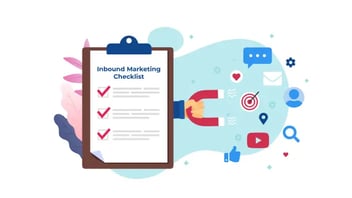Discover how HubSpot Marketing Hub can revolutionize social media marketing. Automate multi-channel postings and leverage AI to maximize engagement.
How Content Marketing and Social Media Work Together
Social media opens the door for your brand to connect with customers on a human level, serving as a powerful channel for distributing your innovative content. So, how can you seamlessly weave social media into your content strategy to help, inform, and uplift your audience?
The difference between content marketing and social media
Companies use various types of content to inform, educate, and entertain prospects and customers by creating awareness around their brand and influencing behavior that results in leads, sales, and advocacy.
Social media encourages communication between prospects and customers. Occasionally, there is communication between the audience and the companies. These interactions are generally more conversational and less structured. Social media is also increasingly being used as a customer support channel.
According to Marketing Solved, the goals of content marketing are consumption and behavior, while the goals of social media are participation and behavior. Social media is the new telephone, and content marketing is the new brochure.
You can extend the reach of your content using your social media presence, which also serves as a direct line of communication between you and your audience.
Also, what was once considered social media vanity metrics, like shares, likes, retweets, and comments, now play a more significant role in search engine results.
Eventually, content and social media will be pulled together as an essential part of an integrated marketing strategy. A brief discussion follows of what you want to do to enable this to happen effectively.
Define your brand voice.
Document your brand voice in a style guide for your organization's content. This is similar to what you did to define your visual brand. Instead of fonts and colors, now you're identifying how to play out your brand's personality in your content. Then, content creators carry it out across all brand channels.
Collect your content and identify its uniqueness from your competitor's content. What sets you apart? Are you an encouraging friend? Are you a data geek? Are you the life of the party? Maybe a trusted advisor? Define what is different about how you communicate instead of how your competitors communicate.
Describe your brand voice in a few words. These few words are to be the guiding force of your content. It's about who your brand is and how you'd like it to be portrayed. Create examples of what to do and what not to do when crafting a content story. Your chosen words determine your conversational tone, cultural references, and what data to incorporate. You're giving whoever creates content a clear idea of what makes that content sound like your brand.
As your company and the market environment change, your brand voice should reflect those changes. Check the relevance of your brand voice guidelines every time you update your content strategy.
Define your social media content strategy.
Now to integrate social media into your content strategy.
Outline what you're doing with your social media presence and how it will tie into your overall content marketing strategy. Identify the structure of your content and what action you want your audience to take.
The relationship between social media and your content is the link to better brand awareness and recognition. If you have owned content that doesn't fit well within your website content, you probably shouldn't display this content on your social channels either.
Remember to engage with your customers and potential customers continuously. Social feeds are not meant to be one-way streams of pushing out branded content. Track everything you can to see where adjustments need to be made.
Each social post needs to stand on its own as a representation of your brand while driving the audience to other relevant content. Include backlinks to your site in your social posts.
-
Brands with integrated social media content consistently see solid engagement. 90% of marketers believe social media has increased their business exposure.
-
Engaging with your customers on social media is key. 71% of consumers with a good social media service experience with a brand are likely to recommend it to others.
-
Backlinks in your social media posts are also crucial - 84% of social media users will take action after seeing a brand post, so make sure you're directing them to relevant content.
-
Incorporating social media into your content marketing efforts can lead to high engagement rates. Brands with integrated social media content see an average of 7x more website visits than those without.
Social Media vs. Content Marketing
If you're trying to tame the social media marketing beast, understanding how social media and content marketing fit together is an excellent place to start. Often, we talk to companies approaching this as an "either-or" proposition: they see these two components as separate, non-related items that can be pursued and managed separately.
While you certainly can use only one or the other, in a comprehensive inbound marketing implementation, social media and content marketing work best in tandem. They can enhance each other in ways that lead to increased conversions, better leads, and, ultimately, more sales.
Content Marketing Gives You Material for Social Media
For the sake of this article, we'll consider content marketing to include long-form content, e.g., blog articles, white papers, case studies, and the like. All these items are terrific for SEO and lead generation. But as importantly, they give you high-quality material to post on social media. After all, why share links to a third-party source when you could send people directly to your website for high-quality content?
Social Media Amplifies Your Reach
Likewise, a robust content marketing strategy benefits from social media. Posting your content on social media amplifies your reach, inviting people who are already engaged with your brand to return to your website. This active outreach is an excellent complement to the visitors you get through organic traffic.
Furthermore, social media makes it easier for followers to share your content with their social networks. With a few clicks, they can pass it along to their peers. In B2B marketing, this feature can be precious; people's LinkedIn networks tend to be skewed to include people with the same or similar backgrounds, industry experience, and roles.
You Might Also Like This Post:
How to Use Social Media for Content Marketing
Effective content creators produce and publish valuable, relevant, and consistent content to attract and retain a clearly defined audience and to drive profitable customer action. Social media is a powerful tool to help you reach a wider audience and effectively promote your content. Here are some tips on how to use social media for content marketing:
Identify your target audience.
Before creating content, you must understand who you are trying to reach. Consider factors such as age, location, interests, and behavior. This will help you create content that resonates with your audience and choose the right social media platforms to reach them.
Understand the different Social Media platforms.
The first rule to ensure success is to understand the differences between all social media platforms so that information can be shared effectively across each one. For example, Twitter's character count is an obstacle that must be overcome. With only so many characters available, businesses that want to incorporate social media into their marketing strategies must make their message loud and to the point. Another thing to consider is the different demographics of each social media platform. Typically, the older generation is more active on Facebook, while the younger generation leans more towards Twitter and Instagram to engage with information. Certain times of day and the chosen day also impact generating the right business flow and should be considered on the different platforms.
Keep an eye on the competition.
Social media is an easy way to check on your competition. Since business profiles are open to public viewing, it's easy to understand what works and what doesn't by browsing the competitor's social media. Reproduce what is successful from your competitors but keep it original.
Create shareable, informative content.
There are many ways to share content: article pages, blog posts, videos, and other ways to share information. Informative website content allows you to rank highly on search engine result pages for essential keywords. Do keyword research, include videos, and use long-tail keywords (niche words used by customers who already know what they are after).
Create a Social Media Calendar.
Creating a schedule ensures that the social media presence remains solid and consistent. Therefore, posts need to be sent out daily. Daily, Scheduling posts with new or recycled material ensures customers remain engaged and find the content relevant and accessible.
Use relevant hashtags.
Hashtags make it easier for people to discover your content on social media. By using relevant hashtags, you can increase the visibility of your content and reach a wider audience.
Engage with your followers.
Social media is a two-way conversation, so engaging with your followers by responding to comments and messages, asking questions, and sharing relevant content from other sources is crucial. This helps to build a community and create a sense of connection with your audience.
Monitor and analyze your performance.
Use social media analytics to track the performance of your content and see how it is resonating with your audience. This will help you understand what is working and what is not and adjust your strategy accordingly.
Integrating social media with content marketing can be a powerful tool. With most of the population already on multiple social media platforms, reaching a broad audience in seconds can be easy. With a few simple rules that can be used to properly and efficiently integrate social media with content marketing, generating leads and growing brand awareness can be done with a "share" button.
This content is also available in:
- German: Wie Content Marketing und soziale Medien zusammenarbeiten
- Spanish: Cómo funcionan el content marketing y las redes sociales
- French: Synergie entre Marketing de Contenu et Médias Sociaux
- Chinese: 内容营销和社交媒体如何协同工作











Leave a Comment